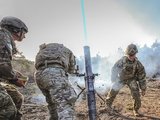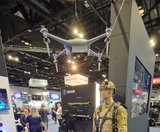Hadean bridges synthetic environment to physical world
The experiment will showcase how integrated teams can rapidly translate emerging, digitally-enabled technology into mission-viable capability. (Photo: Hadean)
Building on a long history of innovating within defence, October Sky aims to provide an opportunity for industry to better understand the end-user’s problems and address emerging technology challenges at pace.
Hadean will pair with AI-driven laser company AIM Defence to power a synthetic environment for AIM’s Fractl C-UAS to be integrated with Hadean’s live, virtual and constructive (LVC) training environments.
Orchestrated by innovation execution (IX) company, Chaos1, the demonstration aims to bring together a number of AUKUS industry, academia and government partners to tackle critical technology adoption challenges currently faced by the Australian Defence Force and boost the Australian DoD’s capacity for outcome-driven innovation.
Related Articles
DSEI 2023: BAE Systems and Hadean continue to collaborate on military training
Hadean unveils latest iteration of spatial computing platform at DSEI 2023
This includes Second Front Systems, a US-based public-benefit software company which accelerates the delivery of mission-critical software solutions and driving advancements in the realm of federal security and technology.
From the end of September, and for the duration of the two-week event, Hadean will work with Chaos1, AIM Defence, and Second Front to demonstrate integration of the Fractl laser C-UAS system in the real world into a common operating picture inside a virtual environment.
The exercise will bridge physical and virtual worlds by bringing a real asset, located in Melbourne, and integrating it into a digital realm deployed in Sydney – over 900 kilometres away.
Focused on providing a solution to one of five strategically aligned technology objectives curated by Chaos1, Sensor Defeat: Counter-crewed and uncrewed systems technologies, the experiment will showcase how integrated teams can rapidly translate emerging, digitally-enabled technology into mission-viable capability for the end-user.
'Enabling repeatable training for both humans and AI to operate novel high-energy CUAS capabilities in a safe and secure environment, with minimal risk, is critical given the increasingly important role of uncrewed aircraft in the modern battlefield,' said Hadean Co-Founder & CEO, Craig Beddis.
AIM Defence co-founder, Jessica Glenn, added: 'Iteration pace is the key factor in AIM’s success. Testing our systems in virtualised environments enables us to move significantly faster while also ensuring that the system is regularly encountering a wide range of operating scenarios. Integrating Fractl with Hadean’s platform allows us to decentralise our testing capability and run simulated engagements anywhere in the world.'
More from Training
-
![Cubic tailors mortar simulator for the US Army]()
Cubic tailors mortar simulator for the US Army
The company’s mortar trainer received improvements based on soldier’s feedback.
-
![Saab expands footprint in the US]()
Saab expands footprint in the US
The company will operate in two new locations in the coming years to better support US services.
-
![How terrain management capabilities can improve military training]()
How terrain management capabilities can improve military training
This type of tool provides more realistic training easing the incorporation of new scenarios that accurately represent the threats of the battlefield.
-
![I/ITSEC 2024: Australian Army approaches second phase of countermining training]()
I/ITSEC 2024: Australian Army approaches second phase of countermining training
The Engineering Corps has been conducting individual instruction using FLAIM Systems’ Sweeper and should start collective deployments in 2025.
-
![I/ITSEC 2024: Zeiss introduces Velvet 4K SIM projector for night flight simulation]()
I/ITSEC 2024: Zeiss introduces Velvet 4K SIM projector for night flight simulation
The next-generation platform is motion-compatible and can be used in OTW and NVG applications.
-
![I/ITSEC 2024: Saab introduces UAV live training capability]()
I/ITSEC 2024: Saab introduces UAV live training capability
The system can be used to prepare soldiers for both drone offensive operations and CUAS missions.

























